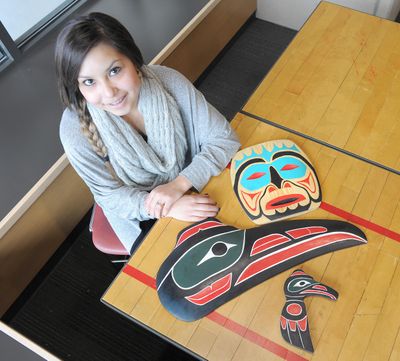School districts add Native American culture to curriculum

MOUNT VERNON, Wash. – Though a channel divides the town of La Conner from the Swinomish Indian Tribal Community reservation, the two cultures are intertwined in Michael Carrigan’s shop class at La Conner High School.
His file cabinets are full of traditional Native American imagery – pictures of salmon, orcas and ravens. In a heartbeat, Carrigan can pull out examples of student-made tools and drums.
For their final projects, students carve totem poles that tell their own stories.
“It’s good for keeping some of the skills alive,” Carrigan said. “It generates an awareness, which creates a respect for other cultures.”
In La Conner schools, the cultural collaboration between the district and the tribe is a way of life.
“The Swinomish tribe and La Conner schools have worked together for a very long time,” said Peg Seeling, the district’s director of teaching and learning as well as its director of assessment. “It’s amazing how much history they have together.”
Thanks to a newly modified state law, school districts throughout the state are now figuring out how to be more like La Conner.
Passed during the 2015 legislative session, the law requires schools to incorporate a state-created curriculum, called Since Time Immemorial, to enhance what students learn about Washington’s 29 federally recognized tribes.
In Carrigan’s classroom, junior Nakesha Edwards is focused on a piece of cedar, carving it into what will soon become a bird.
Carving is a skill Edwards is refining in the classroom, but it’s an art she learned from her uncle, Swinomish Sen. Kevin Paul, who has co-taught classes with Carrigan for more than a decade.
“I want to share the gift of the knowledge that was handed down to me,” Paul said.
Before coming to La Conner, Edwards said lessons about her culture weren’t something she was taught.
“People should learn about our ways,” Edwards said. “But they should learn about different ways as well. Come in with an open mind.”
The curriculum is intended to create more opportunities for kids throughout the state to learn about Native American history and how it has helped shape Washington.
“The intention of the curriculum is to benefit all kids in public education,” said Michael Vendiola, program supervisor for the Office of Superintendent of Public Instruction’s Office Of Native Education. “This is not about focusing only on one particular student group. It’s filling in some of the missing information about the tribal community to the Washington state story.”
Vendiola has personal experience with some of that missing information.
A member of the Swinomish tribe, Vendiola said he’s always had a strong connection to his culture through his tribe. He didn’t attend La Conner schools, and the schools he attended didn’t teach his culture at the same level as his tribe.
“It was a minimum,” he said. “And it was presented in a past tense, as if myself, as a person who identified as a Native American, didn’t really exist in the current society. It was about looking at the past and more of like an anthropological look at how our people lived a long time ago.”
The Since Time Immemorial curriculum addresses sovereignty, treaties and court rulings, topics tribes and neighboring communities deal with every day.
“Having this curriculum in place, (students) will have a different view of what an Indian is and where they come from,” Paul said. “According to the old textbook, we still live in tepees. We’re still ‘wild’ people.”
The move toward a more complete Native American curriculum at the state level began in 2005, Vendiola said. At that time, the Legislature passed a law saying the districts’ implementation of the Since Time Immemorial curriculum was “encouraged.”
Only two districts, Marysville and Fife, officially adopted the curriculum at that time, he said.
In its 2015 session, the Legislature made implementation of the curriculum mandatory.
The curriculum is free to school districts and available online. The districts are encouraged to adapt it to best fit their schools, Vendiola said.
Districts are also encouraged to adapt the curriculum to their local tribes, an idea K.C. Knudson, executive director of teaching and learning for the Burlington-Edison School District, said is important for deeper understanding.